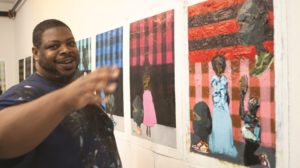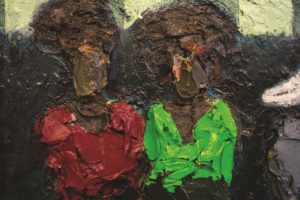Fine Arts Work Center fellow Lavaughan Jenkins insists that his work is not sculpture. Even though it inhabits space in three dimensions, even though you can walk around it, he still maintains that it’s painting. Admittedly, he calls it “three-dimensional painting,” but with Jenkins, the emphasis is on the painting.
“I still work on paper, but when you get to the edges, you have to stop,” he says. “Some artists might continue onto the walls, but there is a cutoff where you don’t see painting happening anymore. With three-dimensional paintings, what you paint on the front ties to the sides and around to the back and up above and back to the front. Everywhere you look, you can see a different painting because it changes with every angle.”

Instead of applying clay or plaster over an armature, Jenkins layers paint. On his kneeling figure titled Please Protect Black Women, currently on display at the Provincetown Arts Association and Museum, Jenkins poured, brushed, dabbed, and smeared seven gallons of acrylic paint as the sculpting material. In using paint in this way, Jenkins not only redefines what a painting is, he examines the medium’s role. Is painting imitating sculpture? Is sculpture morphing into a painting?
“It doesn’t bother me when people say they’re sculptures because I know what I think about them,” says Jenkins. “I intend them to be as painterly as possible. I’m still using brushes. I use the same process and rules of traditional painting. So, if I’m a sculptor, I’m a sculptor with paint. Or a painter that sculpts. Whatever it takes to let people sleep at night is fine with me.”
Jenkins cites the work of Manuel Neri, who painted over his sculptures, as an inspiration. “He was more about the figure, and I’m more about the paint and what paint can do,” says Jenkins. “I’m holding onto the paint world and forcing it into this sculptural idea of pigment.”
Born in Boston and raised in Pensacola, Fla., Jenkins didn’t know he was an artist until he was studying English literature at Roxbury Community College in Boston. He took a drawing course, and the instructor enticed him to transfer to the Mass. College of Art and Design, where he graduated with a B.F.A. in 2005. He found success right after graduation and was showing his work in galleries but says he wasn’t ready for the demands that placed on him.
“It’s strange when you’re not famous but people treat you like that,” he says. “I’m pretty shy, and I just wanted to work, but you have to be out there and show yourself. Maybe that doesn’t happen to every artist, but it happened to me.” Jenkins felt as if he were making work just to sell it. So, he quit painting for six years. He gave away his supplies and started working in bars and restaurants.

It was the 2015 Goya exhibit at Boston’s Museum of Fine Arts that got him back on track. “I dream a lot about artists, and typically, when they come into my dreams, it’s a big alarm to pay attention,” says Jenkins. “I could hear Goya screaming at me that it was time to paint.” Two years later, Philip Guston appeared in a dream, propelling Jenkins to make artwork in three dimensions.
After dreaming of the screaming Goya, Jenkins began the two-dimensional oil-on-paper works that became his Miss Black America series, which evolved into the Protect Black Women series that he’s currently working on at FAWC: 18 paintings tacked in a row along his studio wall in different stages of preparedness for his solo show opening Feb. 9 in the Hudson D. Walker Gallery.
Virtually all of Jenkins’s subjects are women — nobly, colorfully, and abstractly portrayed in thickly layered paint. It’s his way of paying homage to the women in his life. The list begins with his mother, who raised him as a single parent, and his grandmother. It also includes two teachers in Florida who kept him in school when he wanted to drop out, and the gallerists who gave him his first breaks, of whom he says, “They didn’t have to take a chance on my work, but they did.”
For the most part, his memories are positive, but some are negative. “I had a lot of bad relationships that broke up because I was unhappy, and I didn’t realize it until the day I started making art again,” he says. “I was a happier person when I painted.”
Jenkins says he’s going to continue working on paper. As for the three-dimensional work, “I’m not going to make anything small anymore,” he says. “I have seven more large three-dimensional paintings in process in the studio. It’s time for me to make some big pieces like the one displayed in PAAM.”
Editor’s note: An earlier version of this article, published in print on Feb. 10, incorrectly identified an artist who appeared to Lavaughan Jenkins in a dream as “Paul Guston.” It was Philip Guston.
Broad Strokes
The event: A show of works by Lavaughan Jenkins
The time: By appointment, through Tuesday, Feb. 15
The place: Hudson D. Walker Gallery, Fine Arts Work Center, 24 Pearl St., Provincetown
The cost: Free



